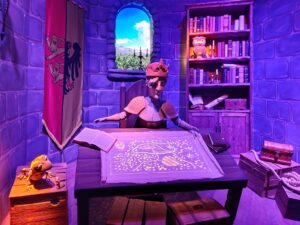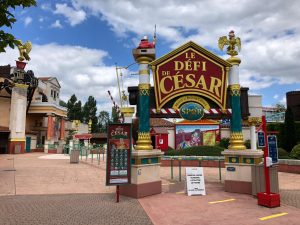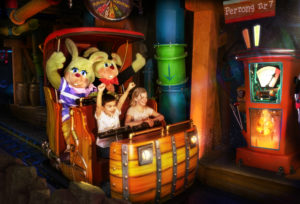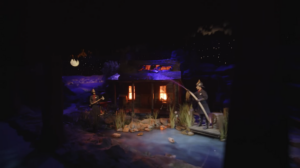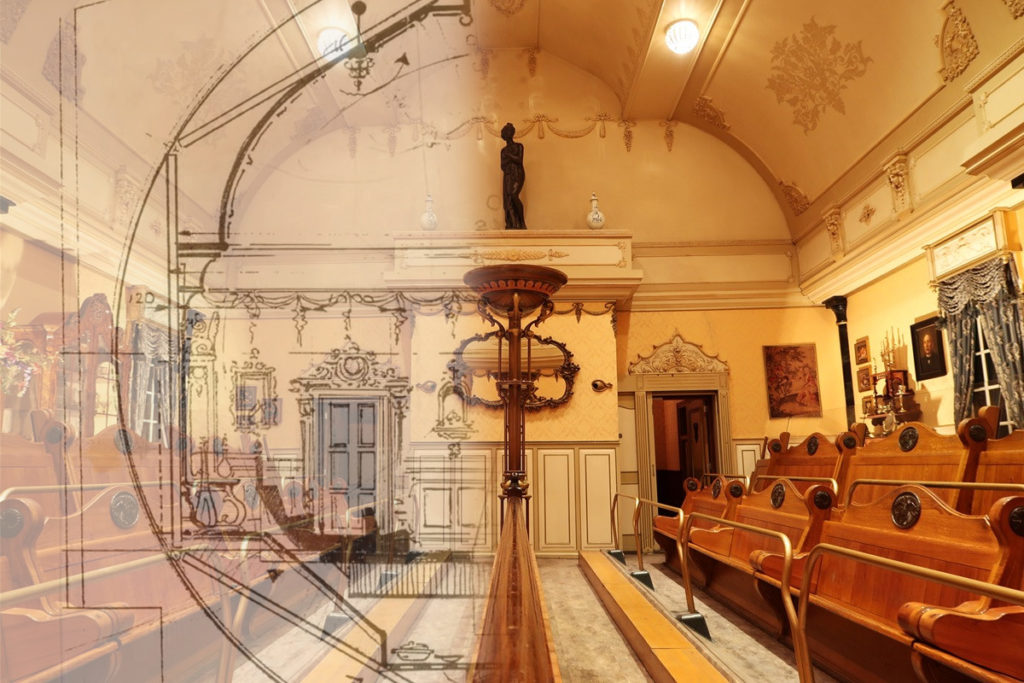
A good show ride can be just as immersive as a good dark ride. The so-called Madhouse proves this once and for all. That’s why in a three part special, we take you along the development of this iconic line of rides. The first part took a look at Haunted Swings, the predecessor of the modern Madhouse. In this second part you will find out more about the development of the first incarnation of the ride type inspired by these old Haunted Swings. Villa Volta at Efteling (Kaatsheuvel, Netherlands) is not just the first of its kind, it single-handedly paved the way for future installations and is arguably still the face of Madhouses worldwide, over 25 years later.
Accompanying us in search of the history of Villa Volta is Lex Lemmens, who was at the forefront of transforming Efteling from a small recreation park to the theme park juggernaut it is today. Lemmens started in 1975 as Chief of Technical Department, would go on to run the park as Head of Operations in the late 80s and fulfilled various roles including Project Manager Research & Development up until his departure from Efteling in 2005. Also joining us in this story is Peter van Bilsen, Executive Vice President of Vekoma, who has been with the company since 1992.
This article assumes a basic understanding of the story and ride experience of Villa Volta. For those not familiar or in need of a refresher, we recommend reading our Spotlight on the subject.
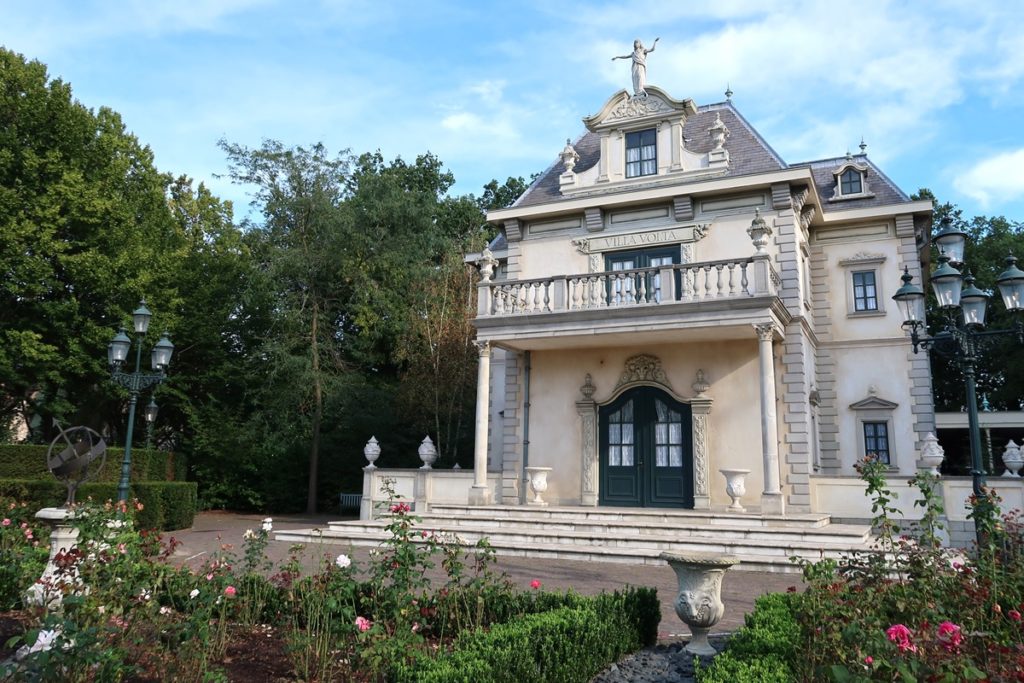
Ton van de Ven and the Wondrous History of Villa Volta
Inspiration
In theme park design, ideas don’t just drop out of the sky, as is the case with Villa Volta. Ton van de Ven (1944-2015) had been involved with Efteling since 1965. He was promoted to Creative Director of the park in 1974 by his mentor, the famous illustrator Anton Pieck. At this point, Efteling consisted primarily of the Fairytale Forest which opened in 1952 and was regularly expanded. The Fairytale Forest was designed by Pieck and, just like the rest of the park, reflects the artist’s style almost exclusively. However, competition in the European theme park landscape was starting to ramp up and visitor numbers began to stagnate.
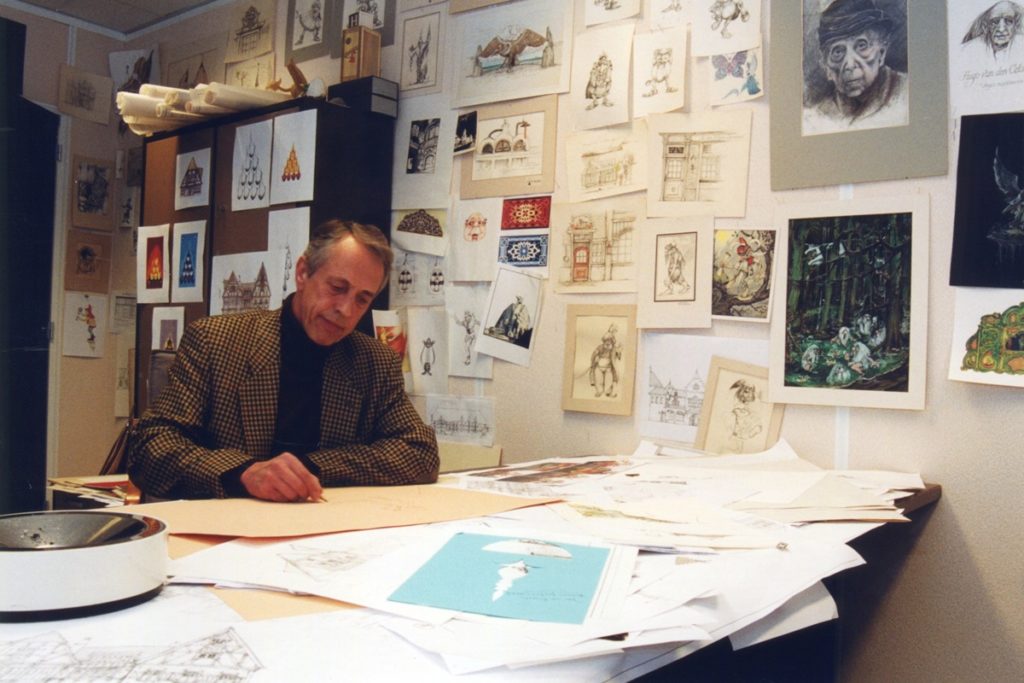
Facing the prospect of having to compete with a growing number of parks and experiences offered within, Efteling decided to look for new types of entertainment to offer its guests. No longer would walking past depictions of fairy tales be enough to keep the interest of the public. Rollercoasters and other mechanical rides were on the rise and would change the scene forever. Van de Ven knew this and it is believed that a modernised revolving house was his first attempt at creating a ride during his starting year as Creative Director in 1974.
As described in the first part of our special, the Haunted Swing dates all the way back to 1894 and thus could be found at a variety of places during this time in the 20th century. Germany was clearly a hot-spot for Haunted Swings, with some installations finding their way to the Netherlands and Belgium. It is known that Van de Ven took inspiration from one of these Haunted Swings during a trip in Germany, although it is not confirmed which one he visited. A commonly known theory that Van de Ven came across a Haunted Swing in 1974 during a work related visit to Luisenpark (Mannheim, Germany) was denied by Lemmens who attended the trip: “Not only is the year stated incorrect as we had only been there in 1975, which is the year I started working at Efteling, I don’t even remember a Haunted Swing being there”. Extensive research on behalf of DRdb has also not resulted in any proof surfacing of a Haunted Swing having ever operated at Luisenpark.
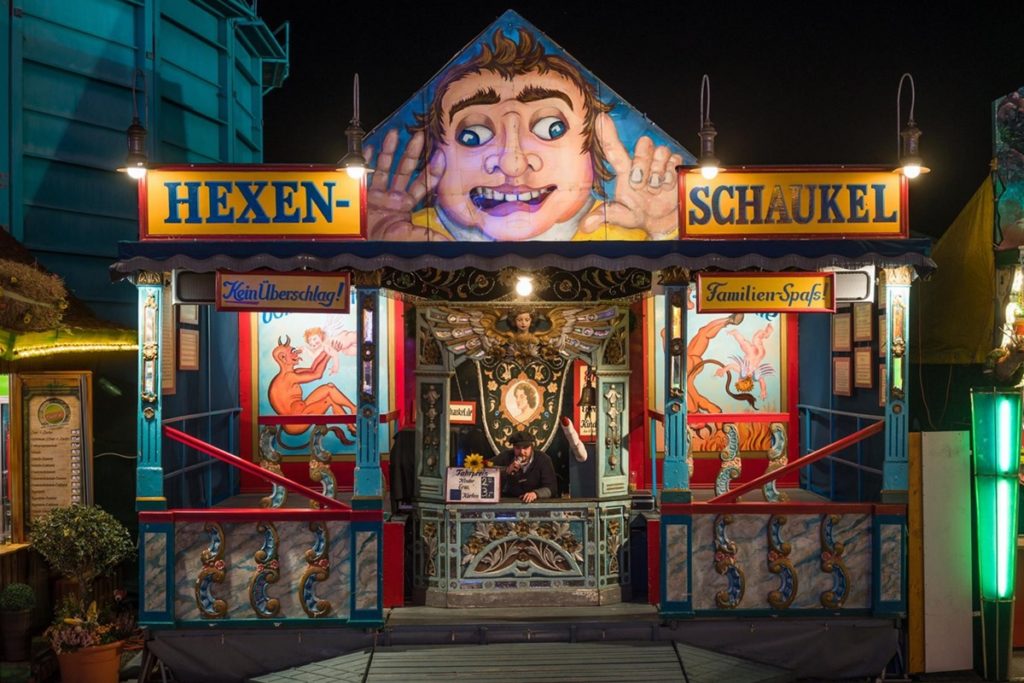
It might remain a mystery forever as to which exact Haunted Swing Van de Ven stumbled upon (Efteling’s 50th anniversary booklet Kroniek van een Sprookje seems to suggest it might have been Herzogschaukel at Blühendes Barock Ludwigsburg). But, him being the pioneer that he was, knew that the concept hadn’t reached its fullest potential and he went on to pitch his own revolving house, reworked to fit within the signature Efteling style, to board members during the mid-70s. The concept, which according to Lex Lemmens might have consisted of just one drawing, was declined. Deemed ‘too funfair-like’. And that was that for the longest time.
Inching forward
Van de Ven would go on to focus on other projects including 1978’s Spookslot, a walkthrough and animatronic show hybrid set within a hauntingly beautiful Celtic castle. Its success cannot be overstated and it proved Van de Ven as a worthy successor to Anton Pieck.
Plans to adapt the illusion would never escape the Creative Director’s mind however and more attempts followed to get the project off the ground. His magnum opus was Fata Morgana, the 1986 Arabian Nights dark ride, which includes a nod to the Haunted Swing. The second to last room rotates slightly and sinks into the water as our boat passes through it. Although the effect’s inclusion was suggested by a third party, it might have renewed Van de Ven’s interest in realising a stand-alone incarnation of the illusion.
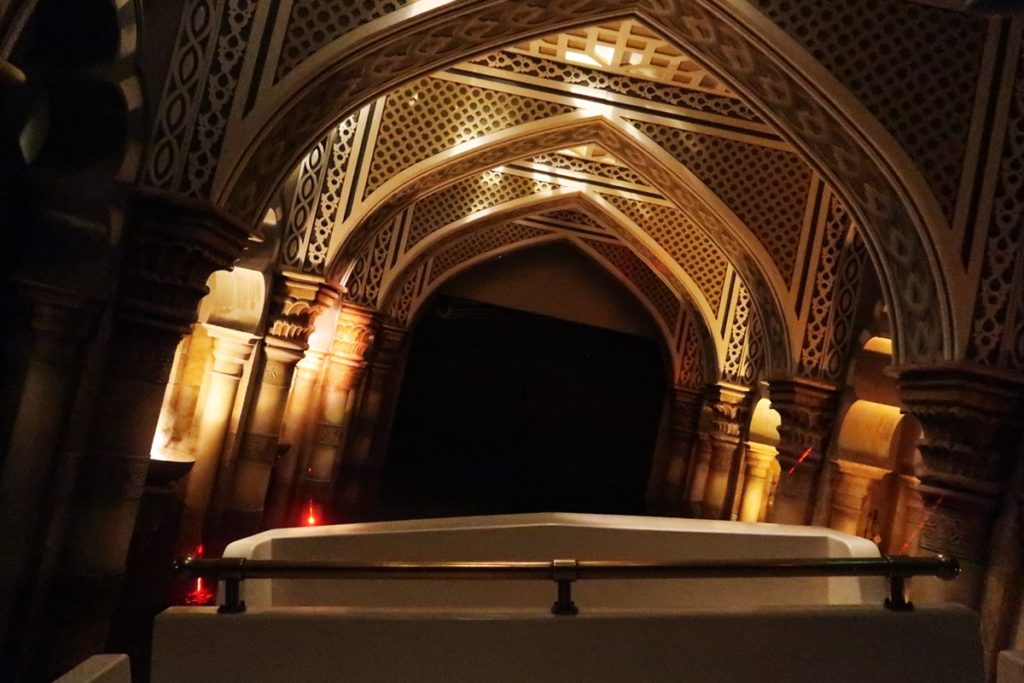
That brings us to 1988, when Van de Ven’s idea for the revolving house was briefly revived. A ride called ‘Villa Vola’ was teased to the press and found its way into the local newspapers. It was described as a ‘’tilting villa’’, however the name roughly translates to Flying Villa in Italian. The origin of this name seems to have been lost to time.
The plans for Villa Vola were very ambitious, with the swing inside offering room for 120 guests at once, a multitude compared to the amount of the average Haunted Swing. Not everyone was convinced just yet though. Lemmens, now Head of Operations, remembers going to visit a Haunted Swing at the insistence of Van de Ven around this time: ‘’I went to see the one in Bobbejaanland [Draaiend Huis], which could accommodate 10 or 12 people. I don’t get nauseous quickly, but I sure did in there. It just wasn’t a comfortable experience. When I spoke to someone from the TÜV [European inspection body] regarding Villa Vola, they replied with: ‘Ah, Sie machen eine Kotzmaschine?’ (‘Ah, you’re building a puke machine?’) I said to Ton that we should pay close attention to a number of things and then it all got postponed…’’
Discussion continued on whether or not actually building Villa Vola was the right choice. Lemmens: ‘’Those old Haunted Swings were not Efteling-worthy. It was out of the question. There was no way we were going to build a rotating house. I even helped prevent it from coming myself.’’ Efteling’s General Manager at the time, Ruud de Clerq, did support the idea and even submitted a building permit for approval. Due to disagreements between him and the Efteling Nature Park Foundation, De Clerq was let go from his position and the building permit was quickly withdrawn. On top of that, the soon to open Disneyland Paris (France) had management worried. Some felt Efteling should just stick to what it knew best and return to its roots of fairy tales. So again, the idea was designated a spot on the shelf and priority was given to other projects like a large scale dark ride to combat the rise of Disney.
A happy accident
Efteling opened the Droomvlucht dark ride in 1993, after which work could begin on the next major project. Board members suggested the creative team to think of a thrill ride, possibly to compete with the soon to be opened Space Mountain at Disneyland Paris. They too had an enclosed roller coaster in mind, but to save time and costs on research and development an off-the-shelf ride was chosen.
An arrangement was made with the German Mack Rides to supply a copy of ‘Eurosat’, their enclosed coaster model which was already installed at Europa-Park a couple of years earlier. However, the Efteling team was disappointed to learn at the last minute that the firm couldn’t possibly fit the order into their busy schedule. The news was brought to them by phone, while already at the airport, ready to board their plane and meet with Mack Rides. Lemmens remembers: ‘’It was a very curious moment, right there at the airport, on our way to sign the contract. We were faced with a ‘fait accompli’.’’
Paul Beck, Efteling’s General Manager at the time, was desperate for a solution. ‘Don’t we have anything else?’ He had only been with the company since 1990 and thus had no idea of Van de Ven’s earlier pitches for a rotating house. Van de Ven saw his chance right then and there to pitch it once again and Beck decided to give it a shot. The very next day, a meeting was arranged to discuss the project’s feasibility.

When asked about how the choice to ultimately build the rotating villa was received internally, Lemmens explains: ‘’Ton was very hesitant about it, because he knew that there was resistance from within the organisation, a few like myself who had experience with the small version. But he was able to convince us on what he had in mind, on how it should be decorated.’’
Development Part 1: Conceptualisation
Starting up
It was now well into 1994 and the entire ride needed to be conceptualised, engineered and constructed before the 1996 season. Lemmens: ‘’The question was, who could help us with that? At the time, I was working on Python Plus [a plan to extend the existing Python rollercoaster], so I had good contacts with Vekoma. I spoke with Vekoma’s Managing Director Roger Houben, and sure enough, he wanted to think along.’’
Efteling had initially found a partner in Vekoma during the realisation of the aforementioned Python, mainland Europe’s largest roller coaster when it opened in 1981. The novelty played a key role in expanding Efteling from a regional park into an international destination and kickstarted a series of investments in thrill rides. The two worked together on other projects after that.
Vekoma was not entirely new to the concept of modernised Haunted Swings. An artwork for the so-called ‘’Haunted House’’ was published in Vekoma’s internal newsletter Crowds in early 1994, along with an idea for an alternative theme revolving around a sinking submarine. Peter van Bilsen of Vekoma remembers from that time: ‘’We often had concepts, some sort of idea that you work on. But you are not going to work it all out right away, you first wait for a customer. And the response from Efteling prompted us to immediately start working on it for real.’’ Lemmens was actually not aware of these concepts at the time.

Vekoma agreed on supplying the technical installations for Efteling, which meant that the development on what was to become Villa Volta could officially start. A team was set up within Efteling to coordinate the project. Leo Pullens was assigned the role of general Project Manager. Ton Merkx and Victor Pelsmaeker focused their efforts on the swing, on the technical and safety side respectively. General Design Coordinator Peter van Ostade was brought in to overlook the programming.
Design and compromise
Like the Haunted Swing before, the ride’s main components were to be the swing in which guests are seated in addition to a drum which spins around the swing and completes the illusion. The starting point for Van de Ven’s design work was the decoration of the rotating drum. He would make over 70 drawings for Villa Volta in total. Lemmens: ‘’Ton wanted to have a room in there, a living room, with an ‘extraordinary amount of kitsch’.’’
Not everything he envisioned could be realised due to technical limitations. For example, the size of the swing had to be compromised. On one of Van de Ven’s earlier drawings, the original 120 seats had already been dialled back to 116, but in a very long arrangement with just 2 rows. With 58 seats on each row, that meant a very long and heavy drum as well. To save on space and budget, the final capacity was calculated as 78 adults. Though in practice, this is rounded up to 80 guests with an arrangement of 4 rows and 20 seats on each. Van Bilsen: ‘’It was 78 to 80, that has more to do with weight. It will fit 80. If you have a lot of kids in it, they are lighter. Anyway, a park takes this into account and it’s only 2 more, so for me it’s 80 too.’’
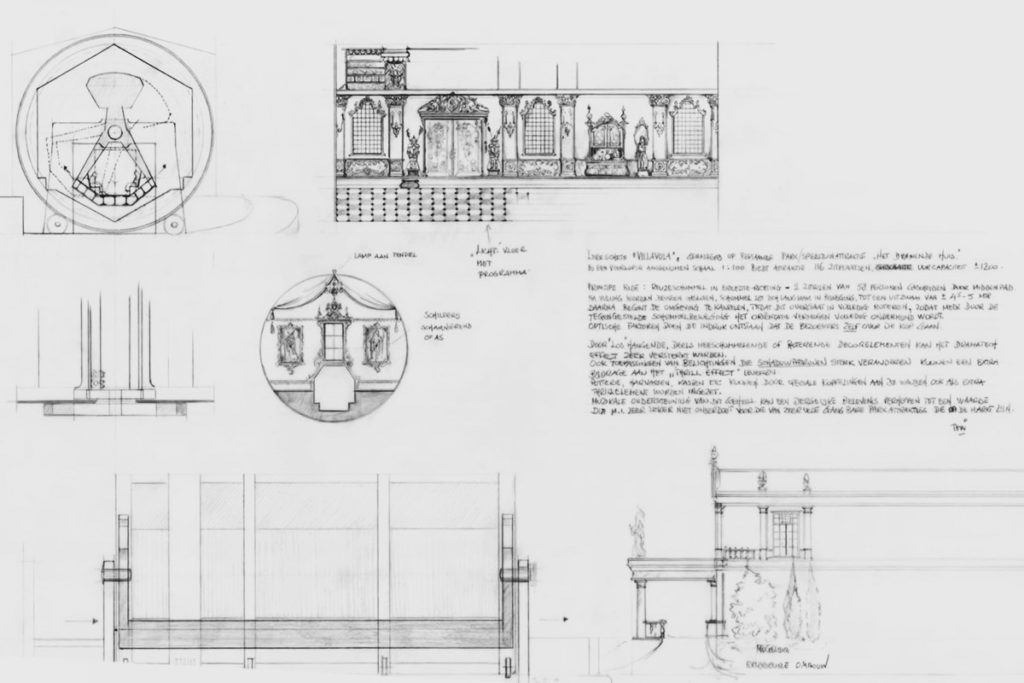
Even with the smaller installation set in place, there were still further limitations. Lemmens: ‘’There was a limit on the amount of weight that the drum can support, but also the distribution of weight was important as it has to be approximately in balance.’’ Some elaborate pieces of theming like a multitude of suits of armour were cut from the living room’s design for this reason.
Lemmens remembers how the outside of the building began to take shape: ‘’The possibilities for the design of the building were obviously limited because the drum had to fit inside. The building is fairly small and the drum is almost pressed up against the outer walls.’’ The outside ended up resembling a Victorian villa, slightly dilapidated, so that it appears to be ‘dripping with rich history’. The location for the ride was chosen to be next to Droomvlucht, in the northern part of the park.
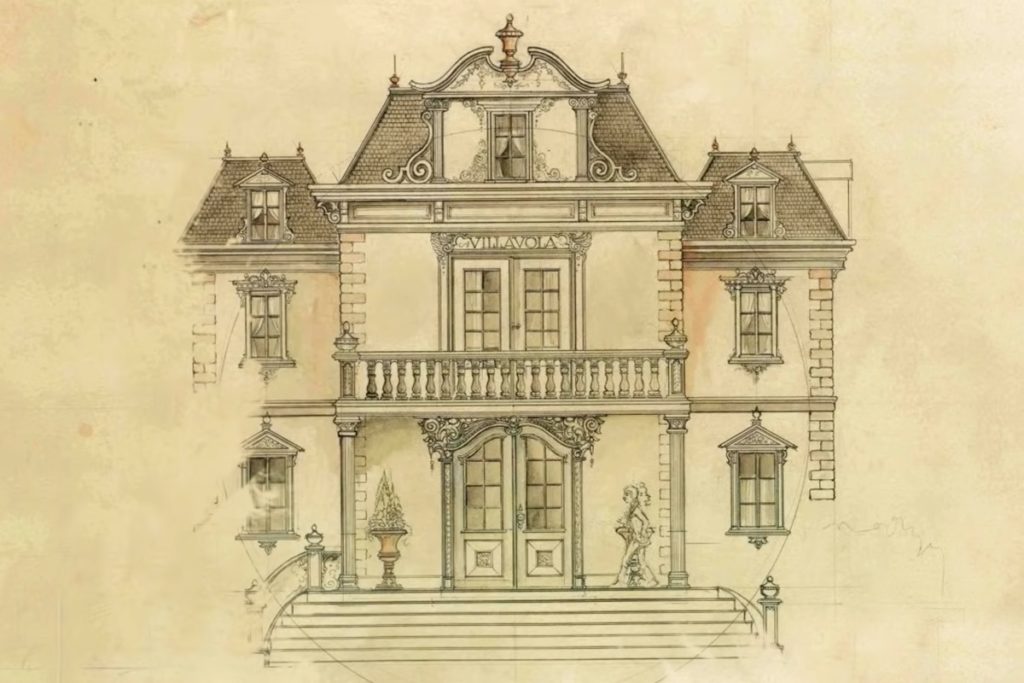
A prototype made from tarp
Meanwhile over at Vekoma, development on a prototype was well underway. It consisted of a narrowed but otherwise full-scale version of the drum and swing inside. Van Bilsen: ‘’We worked together with Efteling on Villa Volta, but in the end we did the entire technical development. The mechanical swing was a challenge to overcome. What kind of drive is needed to get such an enormous mass to move? How do we keep the movements smooth and prevent vibrations? But also one of the challenges was, how is the theming going to influence this? We had to take the weight into consideration from the first stage of development.’’
The walls of the prototype were made from tarpaulin and the swing consisted of 4 simple wooden benches on a platform, offering room for just 8 persons. It had to be controlled entirely by hand, with Vekoma staff pulling on ropes to set the enormous structure in motion.
The optimal diameter of the final 80 persons drum was found to be 10.8 metres and was to become 12.3 metres deep. The hexagonal shape was chosen to limit the amount of surface area to be themed, and thus potential weight.
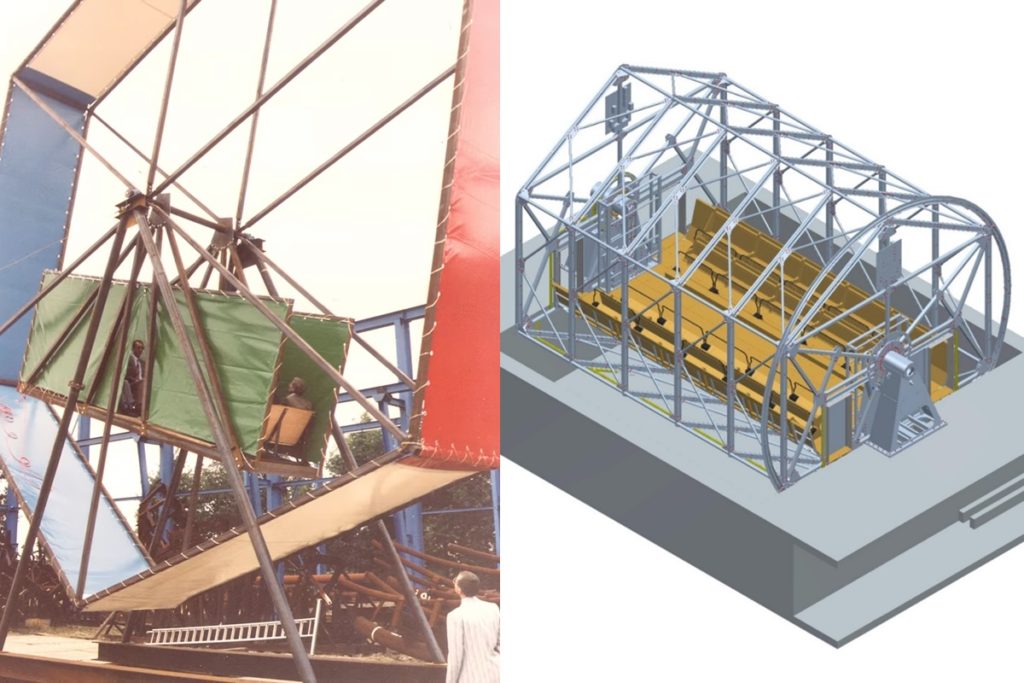
Lemmens went to the Vekoma site with Van de Ven and others to try it out. ‘’We rocked and turned that thing! Then we came to the conclusion that you could indeed program it in such a way that you wouldn’t get sick on it. We had to make sure that was the case, because we had agreed on that in advance with the TÜV.’’ Van Bilsen agrees: ‘’One of the hardest things, I remember, was keeping the motion sickness under control. We hired the TNO [Netherlands Organisation for Applied Scientific Research] to investigate this. That was a very important study.’’
Vekoma would end up supplying the steel hexagonal structure for the drum as well as the swing and the technical installations for both.
The legend of the Buckriders
Apart from being groundbreaking in technology, Villa Volta would break new grounds in terms of storytelling within Efteling. With certain parts of the design already complete, Van de Ven searched for inspiration for a story in fairy tales and legends like he usually did. He found it in the ‘’Bokkenrijders’’, Dutch for Buckriders. The Buckriders is the name of an actual gang of thieves that plagued parts of the Netherlands and Belgium during the 18th century, not far from where Efteling is located. They committed violent robberies on farms and clergy houses.
According to Lemmens, an expert on the matter was consulted by Van de Ven, so he could get to know more about it. The legend tells that the Buckriders were supernatural beings. They supposedly made a pact with demons and traversed the skies during the night on the back of goats.
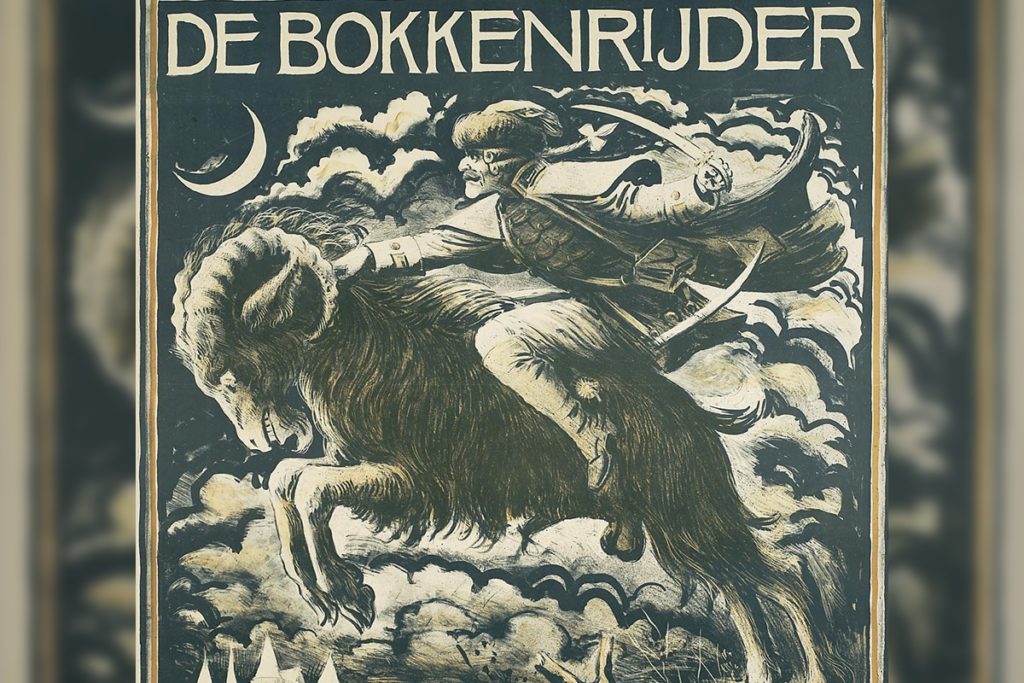
Ultimately, no specific historical event would form the basis for this and Van de Ven’s story would turn into a spin-off. Lemmens: ‘’Ton dabbled into the lore of the Buckriders. He needed a framework to tell a story, that is how Hugo was created.’’ Hugo van den Loonsche Duynen, the fictional leader of the gang, was conceived to serve as the main character, someone to tell the story and connect with the audience. Villa Volta became his manor, filled to the brim with stolen goods. The rotating of the room would work its way into the story by way of a curse bestowed upon Hugo by a mysterious entity known only as ‘’Lady Good’’, who was also given a prominent spot on the roof of his home. Only those with an untroubled conscience could ever lift the curse, which is why Hugo allows strangers (guests) to visit.

Inside the ride, it is hinted at through dialogue in the pre-shows that the Buckrides were powerful, but it is left inconclusive whether or not they actually were supernatural. Also the backstory of Lady Good is kept a mystery. While she is referred to as the spirit of a murdered woman in the press, this is not confirmed within the pre-shows. Similar figures appeared before in existing Buckrider folklore, ranging from reincarnations of Saint Mary to a woman dressing up as a ghost to scare off the Buckriders.
Safety first
To guarantee a safe ride on Villa Volta, a multitude of measures were taken. Van Bilsen: ‘’Safety is our number one priority so that is one of the most important things we worked on.’’
Before the ride can start, a staff member walks in and checks for loose items on the swing while a safety spiel plays. Afterwards, the hydraulically operated safety bars are lowered and the ride can begin. During all times Villa Volta is monitored in the control room to guarantee safety. The operator is also in control of the doors to and from the living room. The pre-shows on the other hand, including timing for the doors in between, are automatic so that the operator can be fully focussed on the living room.
In case of emergency or when the operator presses the e-stop, the drum and swing are automatically adjusted to their zero-points. It is not possible for the drum to remain in its position, even if it is levelled but has made one full rotation, due to a partially unrolled cable for providing the swing with electricity. Once the movements have stopped, the doors are automatically opened and guests can leave the ride through the regular exit.
When dealing with a power outage, a backup generator can provide enough electricity for the booster wheel motors to continue spinning and return the drum to its starting position. ‘’You also can put the drum back into position by hand, but that costs a lot of effort’’, adds Lemmens. The swing and safety bars however, will always need to be manually reset with a hydraulics pressure regulator, and are accessible via one of the drum masts.
For the very rare occasion during which the drum gets stuck and can’t move back into position, the engineers thought of adding escape hatches into the drum. They are, of course, only meant as a last resort. Van Bilsen: ‘’They are situated in places where people can crawl out of, ending up in the cellar. So it may well be that there are also hatches in the ceiling, because if the drum is tilted, then that is the closest hatch to get out. Those hatches were dressed up with plates, and the theming was mounted on those plates. They can simply be taken out. In case that fails, the plates can simply be smashed from the inside or outside.’’ There is no knowledge of a situation where these hatches had to be used in any Madhouse ever.
Nobody left out
Those with a mobility handicap would not be able to enter the living room due to the limited amount of available space and possible difficulties during evacuation. Villa Volta was Efteling’s first ride for which a specialised experience is provided for those not allowed on the ride. Lemmens: ‘’Following my background as Head of Operations at the time, we immediately knew no wheelchairs could get in here. The same had happened with Droomvlucht, which had opened just a few years before. We didn’t want to have another attraction that could not accommodate disabled people, certainly not right next to Droomvlucht.
And then an idea arose. We were in contact with film director Dennis Bots. He was still at the film academy at the time along with Jeroen Zwartjes, who later went on to become Head of the Entertainment Department. We offered them to produce a short movie based on Villa Volta, which they accepted and graduated on.’’ The result was the 24 minute movie Hugo. It is loosely based on the ride and tells the story of how Hugo became the leader of the Buckriders as well as how he ended up cursed. It was played on Dutch television to hype up the opening of Villa Volta.
As an addition to this promotional video, Bots and Zwartjes also produced a 7 minute movie that portrays the ride’s pre-shows and main show in detail. This video was shown to disabled guests in the early years as a compromise for not being able to visit the ride. For this so-called disabled’s show, a small theatre was constructed at the left side of the building which can be entered only after notifying staff.
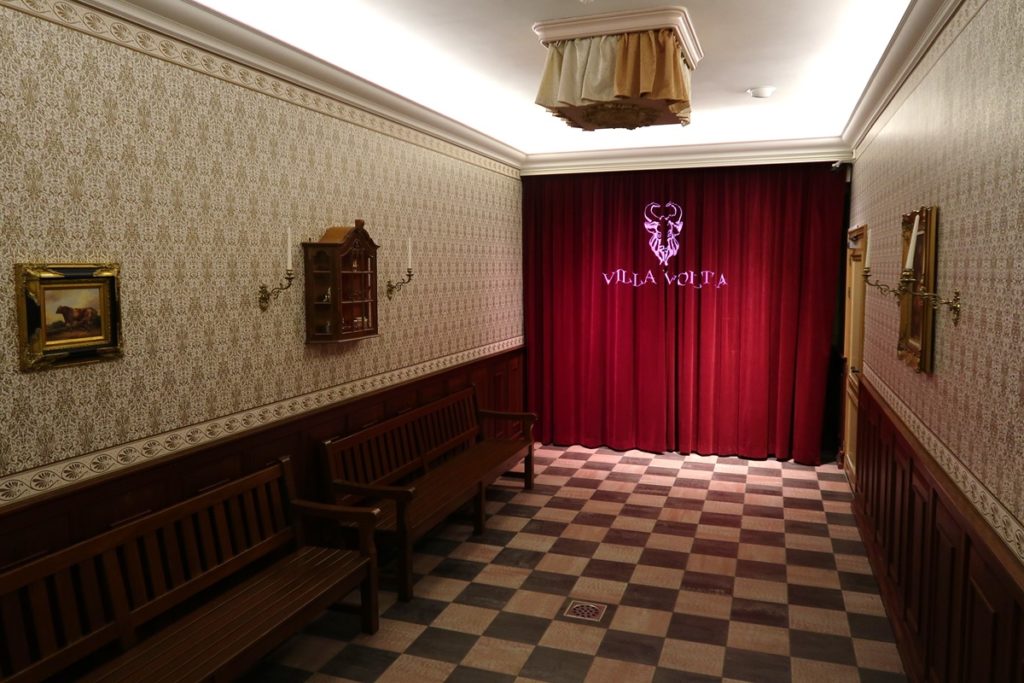
Development Part 2: Construction and Decoration
The first shovel in the ground
With the designs and prototype approved, the construction of Villa Volta could begin. Work on location started in March of 1995 with a budget of 10 million Dutch guilders (approximately €7.5 million accounting for inflation). The foundation was finished in April and lies about 3 metres deep to accommodate the large cellar that houses the technical installations and the bottom part of the drum. The press was notified of Efteling’s upcoming sensation soon thereafter, at that time still known as Villa Vola. It was presented more so as a haunted house, leaving people guessing as to what is to be experienced inside. Beck speaks about it in a local newspaper: ‘’the show is packed with special effects. It will be an exciting thrill ride.’’
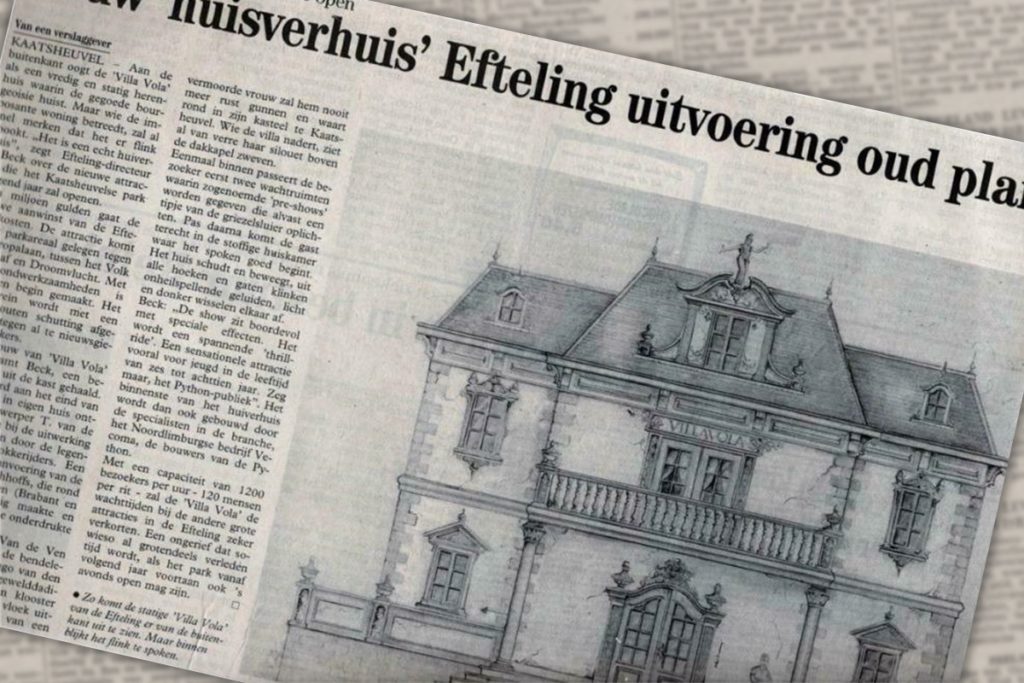
Soon after this publication, Head of Commercial Department Reinoud van Assendelft de Coningh approached Van de Ven concerning his distaste for the chosen name. Some radically different alternatives were suggested but a simple compromise was reached in the form of the more fitting Villa Volta (Italian for ‘’Revolving Villa’’). With the name finalised, the cryptic communication continued within the park boundaries.

Villa Volta is clearly divided into two sections. The front of the building houses the drum and measures in at around 20 metres deep and 14 metres wide. The height is approximately 14 metres, excluding the statue of Lady Good on the roof. This main building was erected first as a steel structure which was finished around July, with bricks built around it later to give it the authentic style Efteling is known for. Only once the façade was finished were the drum, swing and technical installations hoisted in through the still open roof piece by piece. This was done so as to not give away any aspects of the inside and keep it a secret from onlookers.
The back half of the building measures about 10 by 16 metres and is where the pre-shows, the disabled’s show and control room are located. These rooms are only about half the height of the main building and were constructed out of brick solely. The entrance was planned to the right of the building so guests could enter the first pre-show near the back. This also had the benefit of that the queue could start right next to the building’s front. This left room for the exit to be located at the left side of the front, steering guests away from the less decorated backside of the villa. The main queue was equipped with a shelter against sunlight and rain. A massive overflow queue in the open air was constructed to the right side as well, the result of another lesson learned from Droomvlucht, where the original queue was made way too short. Construction of Villa Volta was finished in November at which point staff could begin decorating.
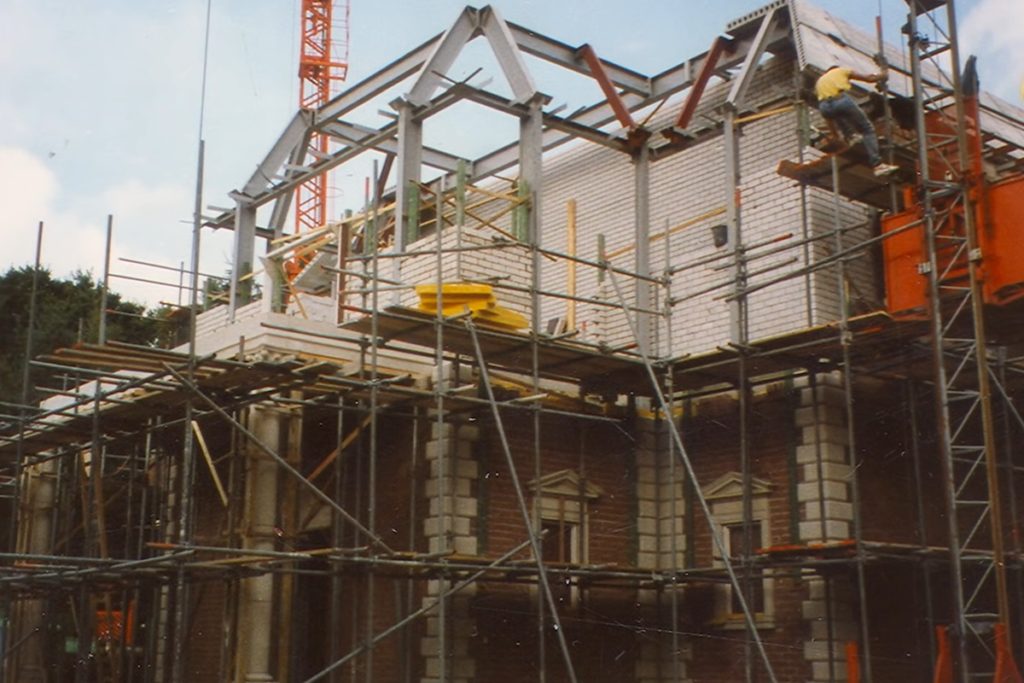
The search for kitsch
The Victorian-era living room needed to be richly decorated, with large antique cabinets, a fireplace, valuable vases, mirrors and paintings on the walls. Additional artefacts like the candle holders with faces give off a creepy vibe. The sides of the swing feature decorative eyes on them which cleverly hide the CCTV cameras. Rows of large pews with Buckrider imagery make up the rest of the interior on which guests are expected to take a seat.
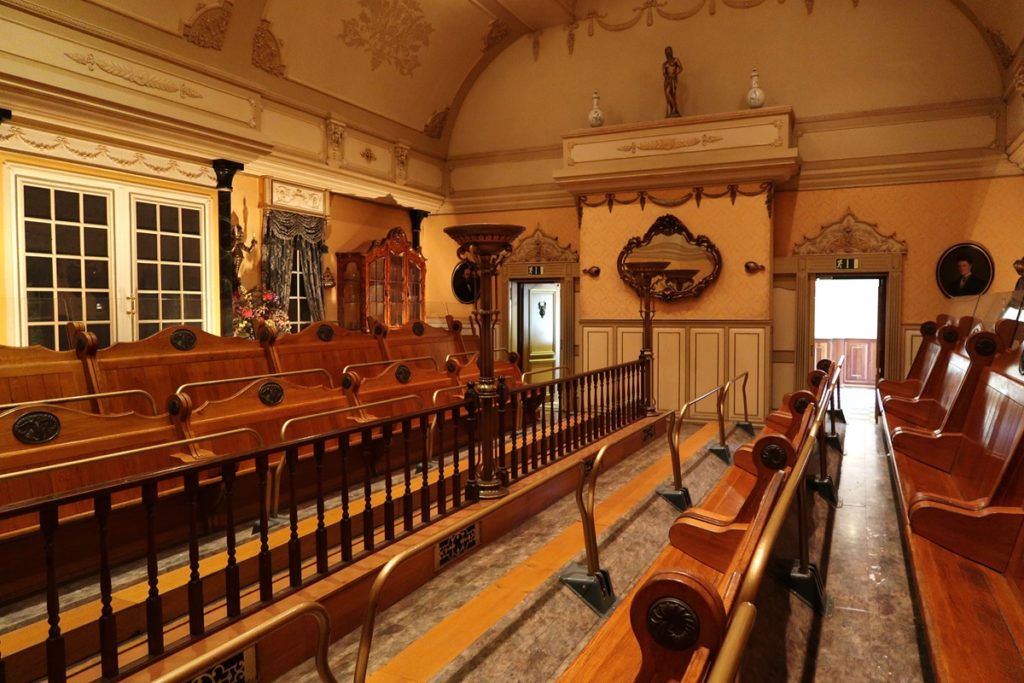
The ‘extraordinary amount of kitsch’ Van de Ven wanted for the living room needed to be as authentic as possible. Lemmens: ‘’We scoured all kinds of stores around here. Take those large cabinets for example, they were just bought at the local thrift store, purchased off-the-shelf. But also people who had old furniture at home that they wanted to do away with, could donate it.” The furniture needed to be securely mounted. In order to not give away the illusion, other items like the curtain tassels were treated with starch spray and decorative elements of the chandeliers secured with iron wire.

Some decor was custom made by Efteling’s design department. The 2 pairs of wall mounted candle holders on each side of the room with evilly grinning faces for example, were specifically designed by Van de Ven. The bottom of the drum was designed with a checkerboard floor but was found to be missing something. Lemmens: ‘’We wanted to include some sort of animatronic. Something had to move, because everything else is static. The solution was to create a ghost-appearance of Hugo inside the floor.’’ Contrary to popular belief, this ghost does not represent the curse being lifted. ‘’The curse is never broken. Because, of course, no one goes in with an untroubled conscience.’’
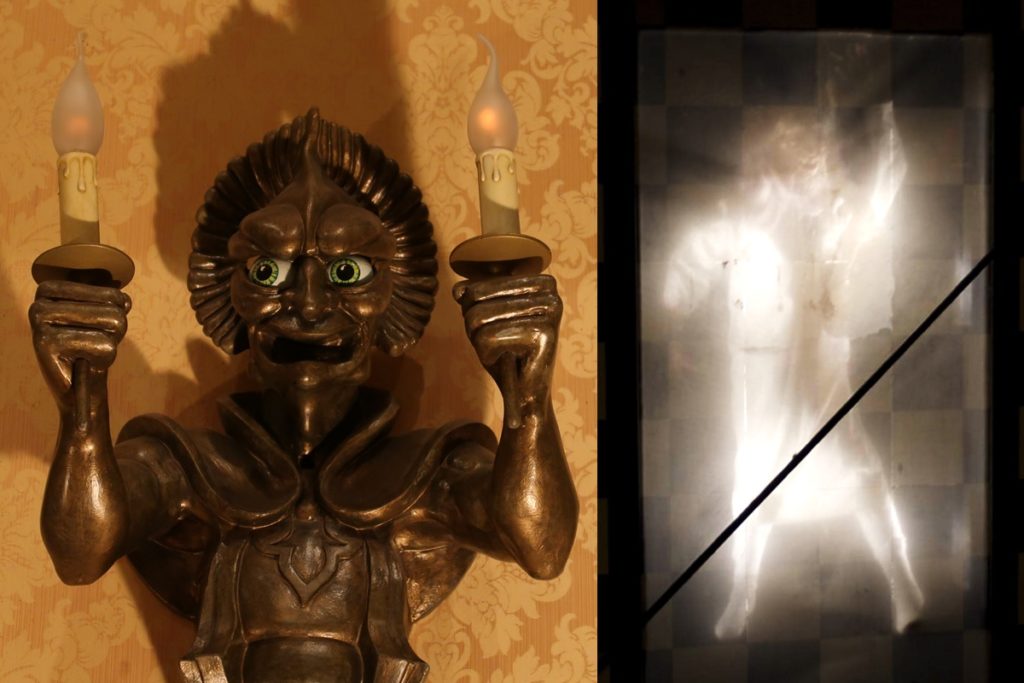
The shows before the show
Two pre-shows were conceived, the first as a way to get the general story of the Buckriders across to visitors. With each 80 guests led inside the first room which resembles a shed, an audio theatre with various actors would play. A narrator starts off the story by explaining the general premise of the Buckriders, followed by villagers expressing their disdain towards them.
Lemmens: ‘’The first pre-show is actually a walk-in event, meant to mask the countdown of the 80 people. That’s why it is already running as the audience walks in but the important dialogues follow later’’. A lot of attention was put into the guest flow and to make it seem as invisible as possible. Originally the pre-show rooms were separated by means of a fence into 2 groups of 40 guests each, to prepare for the upcoming split in the main show. However, they were taken out rather quickly.
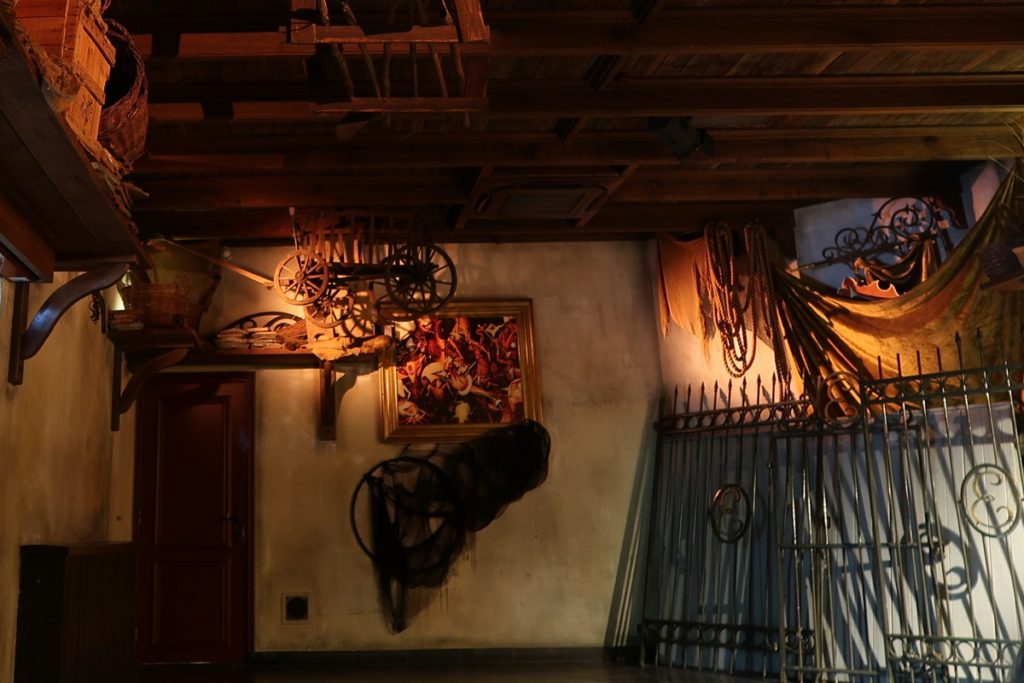
In contrast to previous projects, where Efteling staff members took on the role of voice actors, an agency was hired to find the perfect voices. Van de Ven had final say over the casting. Voice actors with thick regional accents were purposefully chosen for the villagers to drive home the point of the local legend. The narrator is voiced by Hein Boele and for the second pre-show, movie actor Jules Croiset lent his voice to the animatronic Hugo, once in a while backed up with the voice of Lady Good played by Lucie de Lange.
Hugo appears in the second pre-show as an animatronic character, entirely developed in-house. It resembles a messy storage place, in which he has hidden himself among the costly items like chandeliers, golden candlesticks and religious artefacts that he presumably stole from the abbey. Hugo tells the story of how while one day stumbling upon the Postel Abbey and deciding to rob it, Lady Good cursed him and his home. Afterwards, guests are led to the living room to experience the curse for themselves.
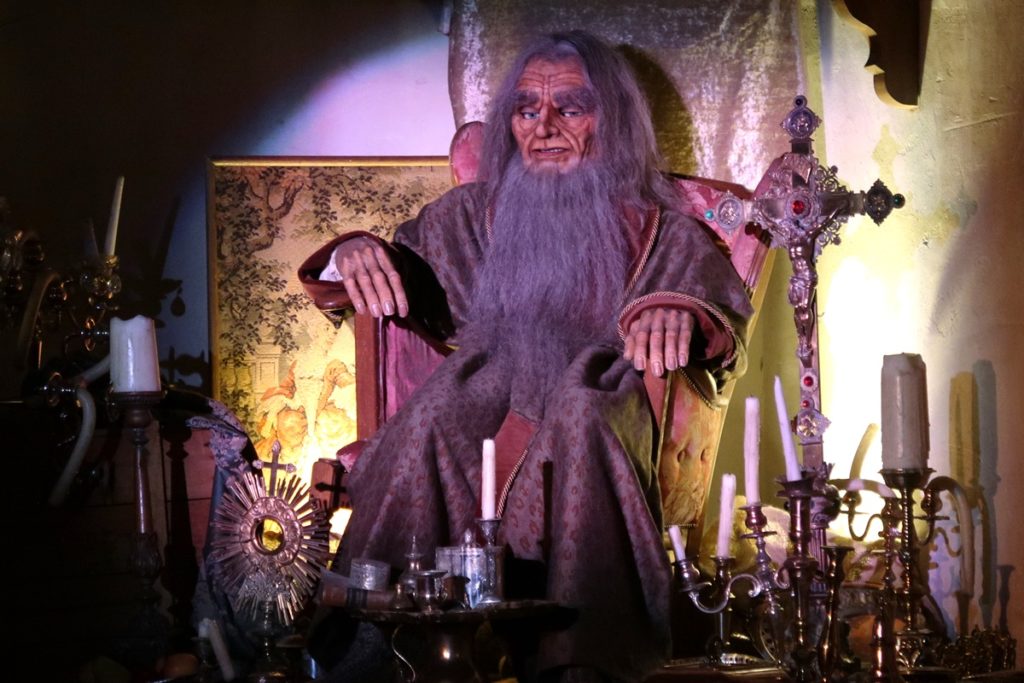
All kinds of old school Efteling items were dragged inside the pre-shows to brighten up the place. Straw baskets that used to serve as trash collectors, an old crest designed by Anton Pieck and a bench taken from the Fairy Tale Forest are hidden among Hugo’s collected goods. Also fencing from an out of commission park entrance was given a new purpose inside Hugo’s home. Lemmens: ‘’The chair Hugo is sitting in came from a staff member’s grandpa. There are also two tapestries in there that belonged to my parents. One can be found in the living room and the other hangs behind Hugo. They were these big, horribly ugly things. My parents wanted to get rid of them so I said, ‘Give them to me, I know a good place for them’.’’

Programming for the perfect soundscape
Van Ostade came up with a timeline on how the show should play out and incorporated as many surprises as possible. Lemmens: ‘’Our goal was to deceive the public. Making them feel something that’s impossible. You notice at the beginning that something is wrong but don’t know what yet, because the drum moves uniformly with the swing. It is very effective.’’
The decision was made early on to support the show with a specially composed soundtrack. Once the first draft of the show programming was written, Lemmens called long-time Efteling composer Ruud Bos: ‘’We told him what the movements would approximately be. He received a timeline and the programming was partly known including the aforementioned first part.’’

Bos is a well-known Dutch composer of film and television music and had been involved with Efteling since 1984. He single-handedly composed the soundtracks for Fata Morgana and Droomvlucht, for which all he needed to get inspired were Van de Ven’s drawings. This was no different for Villa Volta. Even though Bos wasn’t too keen on thrill rides, he underwent the curse of Hugo himself to find out what the fuss was about. Based on the instructions given to him combined with what he felt would fit the grand scope of the Buckrider legend like a choir, he went on to produce a synthesised demo. It was finished in January 1996 and met with praise by everyone on the team. Lemmens: ‘’It was approved immediately, no discussion needed!’’
Bos then produced the final music in a studio in the Netherlands. To work around the limited budget he was given, he decided to hire just a couple of musicians. He let those few musicians play multiple parts which were later overdubbed and thus combined into one piece. In addition to the main show’s theme which lasts approximately 2:30 minutes, another 7:15 minutes was composed for the pre-shows, for which Bos was handed nothing more than the dialogues on paper. Bos’ compositions for these pre-shows are based loosely on the main theme and are almost entirely synthesised. The queue-line also received a unique soundtrack, however it consists entirely of segments from the early demo. Voices of fleeing villagers were added to it in 1998.
With the music recorded and done, the final show programming could begin around February. Lemmens: ‘’We made three programs at the time, one soft, a medium and an extreme one. But we ended up using only one, the one in between.’’ Disaster struck once more during one of the testing rounds. Lemmens: ‘’When Ton first saw those cylinders attached to the swing, he was terrified that there would be a break in the pipes of the hydraulic supply.” Van de Ven’s biggest fear became reality. “He stormed into my office: ‘I told you it would happen! A hose has snapped!’ And he was right. Well, it hadn’t snapped, but a leak occurred and oil was spurting out, all the while the decorations were already put in place. ‘I called it from the start!’, Ton said. By God, he was angry.’’
Luckily, the damage was kept to a minimum and the issue never arose again. ‘’Afterwards, it has always functioned properly. I am not aware of any malfunctions.’’ During the end of March 1996, all loose ends were tied up so Hugo could receive his first guests the following month. Advertising was in full swing, with the short movie Hugo being shown on national television and the 1996 flyer featuring a plea letter from Hugo to come and visit his home.

Reception and Legacy
A round of applause
The day of opening is 4 April 1996. With the paint still wet on the lampposts, a batch of curious visitors line up to experience Villa Volta for the first time. The outside of the villa stayed true to the designs with its plastered walls, stone vases and decorative elements resembling goat faces all over. The mysterious lady on the roof makes curious and curtains obscure any possible view through the windows.
The first reactions start to come in. Hugo’s story was found to be captivating, no doubt thanks to the convincing voice work and animatronic. Visitors experienced the main show in awe and often a round of applause followed after the music had stopped. Press wrote on the one of a kind experience, and while they could often describe how the ride functioned, it didn’t matter as the illusion was just that effective. Villa Volta was found to be a tremendous success, to put it mildly. Lemmens was also impressed with the end result: ‘’It’s one of the stronger attractions at Efteling I think, to this very day.’’
Another surprise was the near immediate release of the main show’s soundtrack as part of a newly put together compilation CD, on which it received the honour of being the first track. Bos was flattered to learn that even international visitors tried to get a hold of him, just to compliment him on his work for Villa Volta. A special merchandise line was created as well, which aside from the usual items like postcards consisted of artwork featuring the villa getting struck by lightning printed on mugs and T-shirts. Efteling also sold the short movie by Bots and Zwartjes on VHS.

In 1997, both Efteling and Vekoma received international praise as they were given the Thea Award for Outstanding Achievement by the Themed Entertainment Association. As part of the deal between the two, Vekoma got the rights for the technology and was allowed to sell the Madhouse to other parks, albeit with different themes. The first of these to open was The Haunting at Drayton Manor, also in 1996.
The invention of the Madhouse indirectly spelled the end for the Haunted Swing. Even though some parks and fairgrounds continue to operate their old Haunted Swings, they are rarely being newly constructed. Instead, the Madhouse pretty much immediately became the industry standard and quickly became one of Vekoma’s most successful products. American amusement park operator Six Flags recognised the Madhouse’s unique combination of theming and thrill and in total ordered 6 installations which opened between 1999 and 2002. In terms of storytelling, most would adapt the basis set by Villa Volta and include one or more pre-shows as well as a story based on a local legend, curse or mysterious character.
German manufacturer Mack Rides threw their hat in the ring and developed their own version of the technology in 2000, which they named the Mystic Swing. The first of these to open was Fluch der Kassandra in Europa-Park. Even former Imagineer Jim Shull was charmed by the Madhouse and tried to pitch the ride type several times within Disney. To say the Madhouse left an impact on the industry is an understatement. Not bad for what was originally supposed to be just another infill.
Alterations and upkeep
Villa Volta might be the oldest Madhouse but it is still held in high regard today and remains a popular ride at the park. Some notable alterations carried out over the years include slightly edited show programmes and technical revisions. The animatronic of Hugo has been revised multiple times in both appearance and programming.
Following his departure from Efteling in 2003, a portrait of Van de Ven was added to pre-show 2 to honour the Creative Director. Van de Ven would state on multiple occasions afterwards that Villa Volta is his favourite creation.
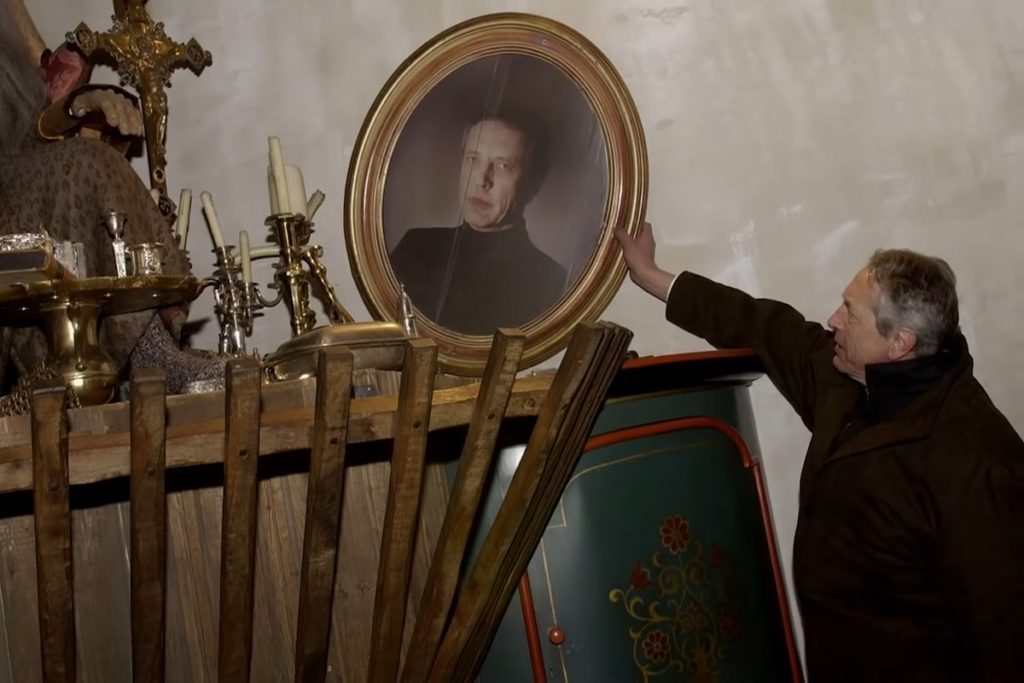
Also in recent times Villa Volta has not been forgotten. The story of the Buckrides was revisited with a four-minute show known as the Magical Illusion. It consisted of projection mapping on the villa’s facade and showed the Buckriders arriving at Hugo’s home after which he gets cursed. Next, the walls open up to reveal the inside of Villa Volta spinning around. The show played during the Winter Efteling event from 2012 until 2021. Voice actor Jules Croiset even reprised his role as Hugo for the occasion. Recently, Efteling celebrated the ride’s 25th anniversary with the release of a collectible pin.
Closing words
‘’I think it’s a fantastic attraction’’, says Lemmens, as the interview comes to an end. ‘’Even though we had so much discussion about it in the beginning, with Ton, the TÜV, and all those who were sceptical about it. But in the end, Ton was right’’.
When asked what his favourite Madhouse is, aside from Villa Volta of course, he explains: ‘’Hex, I really wanted to go see that. [Hex – The Legend of the Towers opened in 2000 at Alton Towers and was Great Britain’s second Madhouse] Ton and I, we were both very excited about it. ‘They did a good job on that’, he said. That’s no idle talk, coming from Ton himself.”
Van Bilsen also has his favourites: ‘’We’ve built about 15 of these rides now, so it’s been quite a successful ride. The one in Parque Warner is one of the most beautiful in the world. Also those of Gardaland, Walibi Holland, Efteling and Phantasialand are very well themed.’’ Also the 3 Houdini Madhouses by Six Flags are a favourite of Van Bilsen.
This concludes our story on the first Madhouse. We would like to thank Lex Lemmens and Peter van Bilsen once again for their stories about the development of Villa Volta. In the final part of our Madhouses special trilogy we will take a look at some other notable installations in detail as well as the technical workings of the Madhouse.

References
Sources:
- Efteling – Villa Volta – De Magische Klok (https://youtu.be/coaCDq7DrMs)
- Eftepedia – Lex Lemmens (https://www.eftepedia.nl/lemma/Lex_Lemmens)
- Eftepedia – Ton van de Ven (https://www.eftepedia.nl/lemma/Ton_van_de_Ven)
- Eftepedia – Villa Volta (https://www.eftepedia.nl/lemma/Villa_Volta)
- De Vijf Zintuigen – Documentaire Ruud Bos (https://youtu.be/wtJQDpinXGk)
- De Vijf Zintuigen – Interview Ruud de Clercq (https://youtu.be/zgDtzxzXUpc)
- Kroniek van een Sprookje (Henk vanden Diepstraten, 2002)
- Crowds Volume 2 Issue 1 (Vekoma, 1994)
Further reading (and watching):
- Wikipedia – Buckriders:
- https://en.wikipedia.org/wiki/Buckriders
- Construction images of Villa Volta by Efteling Nostalgie:
- https://www.eftelingnostalgie.nl/artikel/villavolta/villavolta.html
- Magical Illusions at Villa Volta by Efteling on YouTube:
- https://youtu.be/15IR-iIBxwQ
Images courtesy of:
- Dark Ride Database
- Efteling Beeldbank (https://www.efteling.com/nl/pers/media-library/)
- Hexenschaukel (https://www.facebook.com/hexenschaukel/)
- Efteling via YouTube (https://youtu.be/coaCDq7DrMs, https://youtu.be/oWeWCVi-5ec)
- Wikimedia
- Vekoma
- Scj Heinen (https://www.scjheinen.nl/)
- Brabants Dagblad
© 2022 Dark Ride Database
Interviews by Erik, Luc, Quintus and Jim
Article by Jim
Pictures of Villa Volta by Jim

